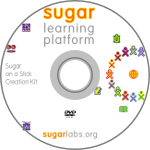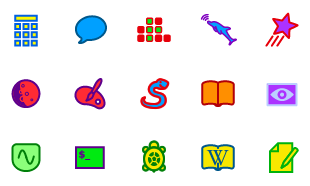Difference between revisions of "User:Walter/Get Sugar"
m (→Virtual Machines on all platforms: link to other virtual machines) |
|||
| Line 118: | Line 118: | ||
:If you run into problems, you may want to consult the [[Talk:VirtualBox]] page for help. | :If you run into problems, you may want to consult the [[Talk:VirtualBox]] page for help. | ||
|- | |- | ||
| − | | ||Other virtual machines | + | | ||'''Other virtual machines''' [http://wiki.sugarlabs.org/go/User_talk:Walter/Get_Sugar] may also work but have not undergone testing with our images. |
| − | + | ||
| − | |||
| − | |||
| − | |||
| − | |||
| − | |||
| − | |||
| − | |||
| − | |||
| − | |||
| − | |||
| − | |||
| − | |||
| − | |||
| − | |||
| − | |||
| − | |||
| − | |||
| − | |||
| − | |||
| − | |||
|} | |} | ||
Revision as of 11:59, 17 September 2010
Are you new to Sugar?
The easiest way to get started is to use Sugar on a Stick. Basic instructions are found below. A more detailed Sugar-on-a-Stick Creation Guide is also available. (If you already use GNU/Linux, you may want to install the Sugar packages available from your distro.)
MS Windows
| (1) Prepare: Download the Fedora Live USB Creator from FedoraHosted | |
| (2) Download: Download the Sugar-on-a-Stick iso. | |
| (3) Burn: Insert a USB flash drive (or SD Card) with 1 GB or more of free space into your computer and launch Fedora Live USB Creator to create a Sugar-on-a-Stick bootable image. Note: Be sure to set the persistent storage slider to a non-zero value. | |
| (4) Boot: Insert the USB stick into a USB port on your computer. Set the option to "boot from USB" in your computer's BIOS, and then start up the computer. |
Detailed installation instructions for Windows and booting instructions are available. There is also a guide to using Sugar on a Stick.
GNU/Linux
GNU/Linux users may want to install the Sugar packages on their favorite distro.
 |
(1) Prepare: Use this script http://bit.ly/livecd-iso-to-disk to create a bootable image. (Run chmod +x livecd-iso-to-disk.sh after you download the script to make it executable.)
|
| (2) Download: Download the Sugar-on-a-Stick iso. | |
| (3) Burn: Execute, as the root user, in one command with arguments, the following:
| |
| (4) Boot: Insert the USB stick into a USB port on your computer. Set the option to "boot from USB" in your computer's BIOS, and then start up the computer. |
Detailed installation instructions for GNU/Linux and booting instructions are available. There is also a guide to using Sugar on a Stick.
Apple OSX
DRAFT: These instructions are incomplete. Please help with testing and documentation. You may want to refer to the Virtual Machines instructions below.
| (1) Prepare: These instructions are only for 64-bit machines. (To identify processor, choose Apple menu > About This Mac. A small window will appear titled About This Mac. The processor type is displayed in this window. Sugar on a Stick is for the Intel processor only.) | |
| (2) Download: Download the Sugar-on-a-Stick iso. Be sure to download a 64-bit image. | |
| (3) Burn: Does someone have a simple way to burn a Live USB on a Mac? | |
(4) Boot: Insert the USB stick into a USB port on your computer. Is this correct?: During the startup sound, press and hold the c key. If the Apple logo appears, Sugar is not booting. Restart and try again.
|
Alternative installation instructions for OSX Also, these older installation instructions and booting instructions are available. There is also a guide to using Sugar on a Stick.
Advanced users
 |
|
Do you have an OLPC XO?
 |
|
Do you use GNU/Linux?
Select your favorite distribution |
| |||||||||||
| Or try a Live USB version of Sugar |
Virtual Machines on all platforms
| (1) Prepare: Download Sun VirtualBox (It is recommended that you read this first.) | |
(2) Download: Download these three files:
| |
| (3) Launch: VirtualBox | |
(4) Import: soas-v3-Mirabelle.ovf from the Import Appliance option under the File menu.
| |
| Other virtual machines [1] may also work but have not undergone testing with our images. |
Are you a developer?
| Learn how to get setup on the Supported systems page. | |
 |
Some additional references you may find useful:
|
Are you preparing a deployment without Internet access?
| See Sugar Creation Kit |
Are you looking for Sugar Activities?
| Visit the Activity Portal | 
|





